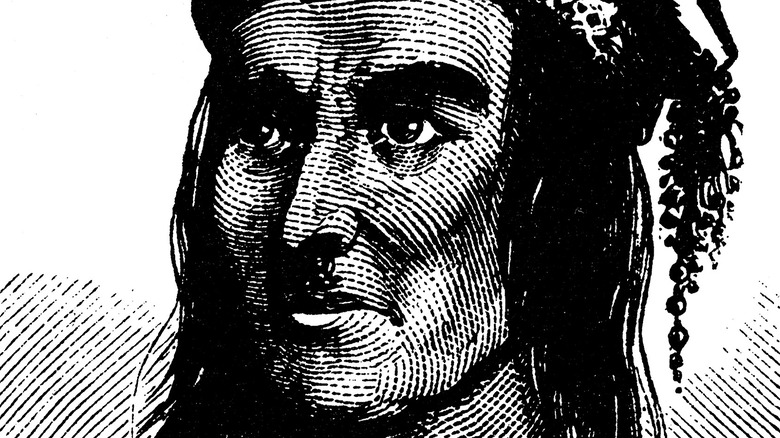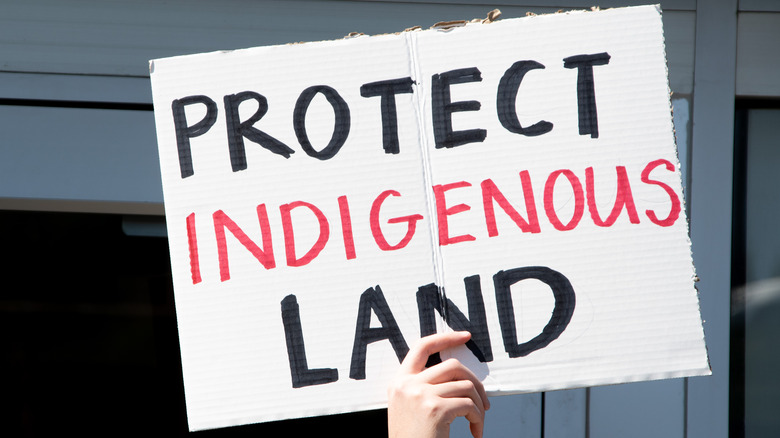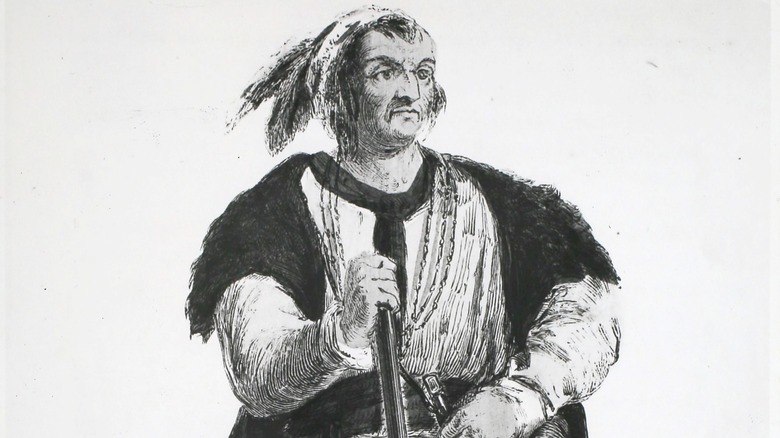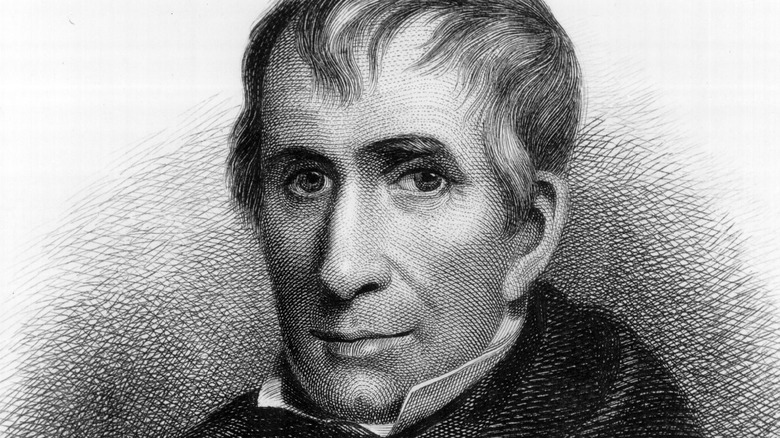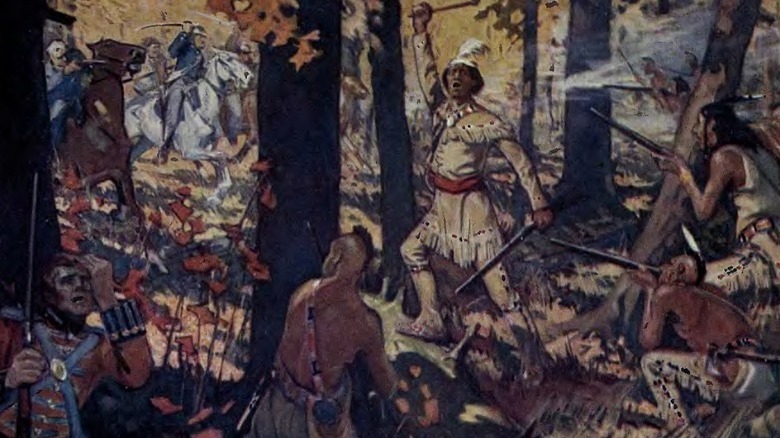Shawnee Chief Tecumseh's Death Changed Native American History Forever
In 1794, in the area now referred to as Ohio, an epic battle was playing out across the land between white colonists and Native American residents. This particular armed conflict was known as the Battle of Fallen Timbers (via Britannica), wherein forces from the confederated Native American tribes Lenape, Miami, and Shawnee rose up in defense of their land against armed enemy forces, namely the United States army.
In what History reports was a "decisive victory" for American colonial troops, one Shawnee soldier by the name of Sauwauseekau would take his final breaths there along the Maumee River, his younger brother watching in horror as his third and final family member succumbed to frontier violence. That surviving brother's name was Tecumseh, born leader and warrior with a penchant for justice and a vision of uniting all Native American tribes. While the leadership and military prowess of Tecumseh was short-lived on the battlefield, his enduring legacy would go on to forever alter Native American history in particular and the nation's history as well.
As a young warrior, Tecumseh sought to unite Native American tribes
Smithsonian Magazine reports that by the tender age of 15, Tecumseh was every bit the warrior his father and brothers raised him to be. As he clambered across the countryside waging war against not only a massive enemy army but also and more importantly an anti-Native American ideology, he did so with a vision. Through fierce combat and leadership, he aimed to reunite all nearby and neighboring tribes. If successful, he'd command an army of at least 100,000.
According to History, by 1810, Tecumseh had successfully united multiple tribes, banding them together to build a confederacy. Among them were the Potawatomi, Kickapoo, Wyandot, Menominee, Ottawa, Winnebago, and, of course, the Shawnee tribe from which he hailed. With such a formidable union under his command, staving off colonial invaders proved possible, but in the end, his greatest efforts still only served to stall the violent upheaval and separation taking place. If he truly wanted to defeat the armed American forces in their expansionist war for the frontier, he would need an even larger army. Fortunately, there was one at his disposal.
He joined the British in the war against American forces
According to Smithsonian Magazine, Tecumseh's Pan-Indian vision was certainly not short-sighted. Recognizing the American army as a common enemy, the chief warrior opted to join British forces on the battlefield. He was particularly keen on these British troops because, unlike the American army, the British did not appear to have a vested interest in invading the Shawnee and other native tribal territories.
Now, with a fierce army and well-equipped allies, Tecumseh led his troops into the Battle of Tippecanoe, which would later go down in history as the first battle in the War of 1812, despite having taken place in 1811 (via Britannica). In August of 1812, Tecumseh would further set the tone for the war, driving Brig. Gen. William Hull's 2,000-man militia out of Detroit with a multitribal, multi-national force. At the time, colonial soldiers smeared Tecumseh and his brigade, calling them "savages" in a stereotypical tone. All this would later change in Tecumseh's post-death legacy, which would serve to alter the public's perception of Tecumseh, and by association, his tribe.
In life, Tecumseh was regarded as an unparalleled threat, but his people were often mocked
Before aligning with the British militia, Tecumseh suggested a more peaceful approach. National Park Service reports that he even considered acceding to some of the white settlers' expansion, so long as they ceased to continue their expansion into more native territory. His precise words to William Henry Harrison in 1810 were an ominous warning: "I want the present boundary line to continue ... should you cross it ... I assure you it will be productive of bad consequences."
Smithsonian Magazine reports that although Harrison refused to abide by the agreement, he did respect and even fear Tecumseh, calling him "one of those uncommon geniuses, which spring up occasionally to produce revolutions and overturn the established order of things." Harrison also noted the steadfast obedience of the chief's followers as proof of the claim.
While Tecumseh was revered as a rare genius and an unparalleled threat to colonialism and expansion, people hailing from the tribes he represented were still chided as "savages" in historical accounts. This kind of paradox would find new meaning once Tecumseh died on the battlefield. It was in this paradox that the term "noble savage" was born (via Facing History).
In death, he was heralded as a noble, valiant hero which rewrote some of Native American history
In October of 1813, the fierce warrior and leader who managed to unite multiple tribes and ally with British troops engaged in a battle from which he would never return. This was the notorious Battle of the Thames (via Battlefields), originally led by both Tecumseh and British General Proctor. On the battlefield, the British army, growing more hungry and less powerful with every passing rifle shot, eventually retreated from the fight, leaving Tecumseh and his tribe to fend for themselves against General Harrison (above) and his host of mounted rifles.
Considered by most historians a grave betrayal on behalf of the British, the tribes fought on, exhausted, gunpowder clouding up the swamp along the Thames River, blood floating up from fallen soldiers. Some of that blood presumably belonged to Tecumseh, though nobody can say for sure, since the victors mutilated the bodies beyond recognition. According to Smithsonian Magazine, Tecumseh went on to be a legend, and perhaps the first Native American to be referred to as a "Noble Savage," a term that certainly has its share of critics.
Misgivings and myths aside, post-war America abounded with depictions of Native American chiefs as "noble savages." Facing History defines this depiction as "brave but honorable warriors and beautiful princesses, gifted orators, and creatures of innocence and simplicity living from the bounty of nature."
Questions surrounding the true circumstances of Tecumseh's death remain a mystery
Smithsonian Magazine reports that the Shawnee chief whose life united Native American tribes sparked international controversy once he was said to have died on the battlefield. The first element of mystery is, of course, whether or not he actually died in the swamps of that ill-fated battlefield in 1813. Surely, no recognizable corpse was ever presented. In one instance, a battered dead body was heinously mutilated by white American soldiers who believed it to be the deceased chief. Other accounts seemed to claim that Tecumseh actually survived and was secretly hiding out in a place far from the watchful, unforgiving eyes of the invaders.
Adding to the mystery was the myriad of Americans who claimed to have themselves taken down Chief Tecumseh. Among these was Colonel Richard Johnson, whose political career was ultimately hinged on the idea that he single-handedly defeated the brave warrior. As time wore on, further exaggerations of both the battle and the presumed death of the Shawnee chief became widespread, touching pop culture in never-before-seen ways.
Regardless of his cause of death, Tecumseh's enduring legacy has carried on. To this very day, he is ranked 37th on the list of Greatest Canadians (via Your Dictionary). Perhaps his most inspiring mark on history is neither death nor prowess but vision. His army of united tribes was an undeniably formidable force.
